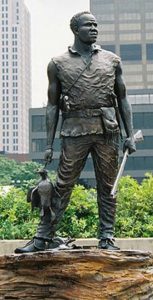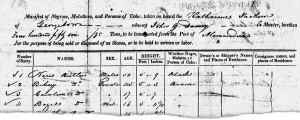Slaves
York…say his name.
June 10, 2020@SHEDELL6
‘This is York. He was part of the Lewis and Clark expedition. York was a slave and even after his faithful service to the expedition they refused to liberate him. The whole PNW worships Lewis and Clark but little mention of York.’
‘…the task of making amends.’
April 16, 2016NYTimes
—
‘272 Slaves Were Sold to Save Georgetown. What Does It Owe Their Descendants
More than a dozen universities — including Brown, Columbia, Harvard and the University of Virginia — have publicly recognized their ties to slavery and the slave trade. But the 1838 slave sale organized by the Jesuits, who founded and ran Georgetown, stands out for its sheer size, historians say.
At Georgetown, slavery and scholarship were inextricably linked. The college relied on Jesuit plantations in Maryland to help finance its operations, university officials say. (Slaves were often donated by prosperous parishioners.) And the 1838 sale — worth about $3.3 million in today’s dollars — was organized by two of Georgetown’s early presidents, both Jesuit priests.
[…]
“This is not a disembodied group of people, who are nameless and faceless,” said Mr. Cellini, 52, whose company, Briefcase Analytics, is based in Cambridge, Mass. “These are real people with real names and real descendants.”
Within two weeks, Mr. Cellini had set up a nonprofit, the Georgetown Memory Project, hired eight genealogists and raised more than $10,000 from fellow alumni to finance their research.
Dr. Rothman, the Georgetown historian, heard about Mr. Cellini’s efforts and let him know that he and several of his students were also tracing the slaves. Soon, the two men and their teams were working on parallel tracks.
What has emerged from their research, and that of other scholars, is a glimpse of an insular world dominated by priests who required their slaves to attend Mass for the sake of their salvation, but also whipped and sold some of them. The records describe runaways, harsh plantation conditions and the anguish voiced by some Jesuits over their participation in a system of forced servitude.
“A microcosm of the whole history of American slavery,” Dr. Rothman said.
The enslaved were grandmothers and grandfathers, carpenters and blacksmiths, pregnant women and anxious fathers, children and infants, who were fearful, bewildered and despairing as they saw their families and communities ripped apart by the sale of 1838.
The researchers have used archival records to follow their footsteps, from the Jesuit plantations in Maryland, to the docks of New Orleans, to three plantations west and south of Baton Rouge, La.

